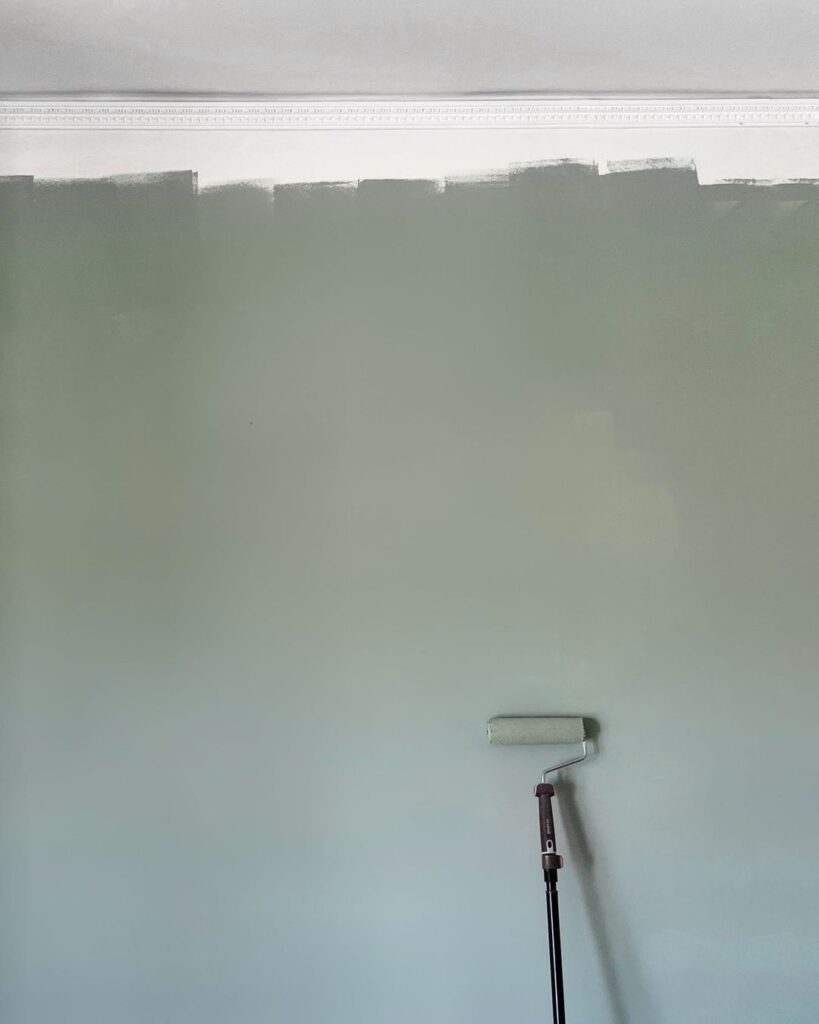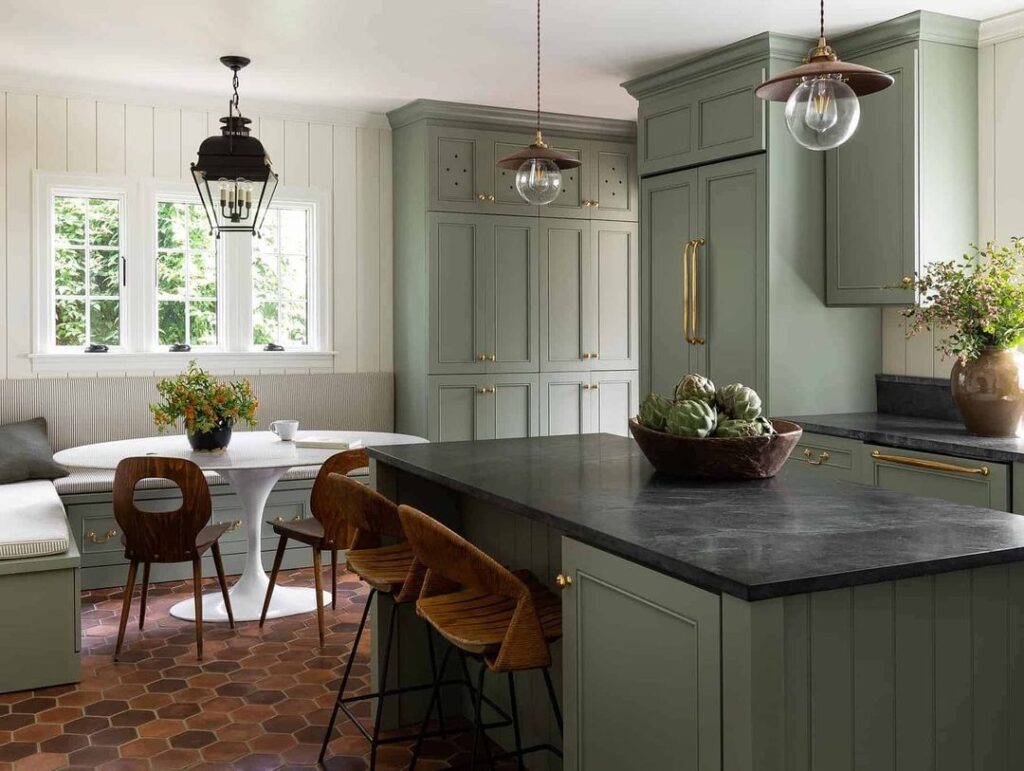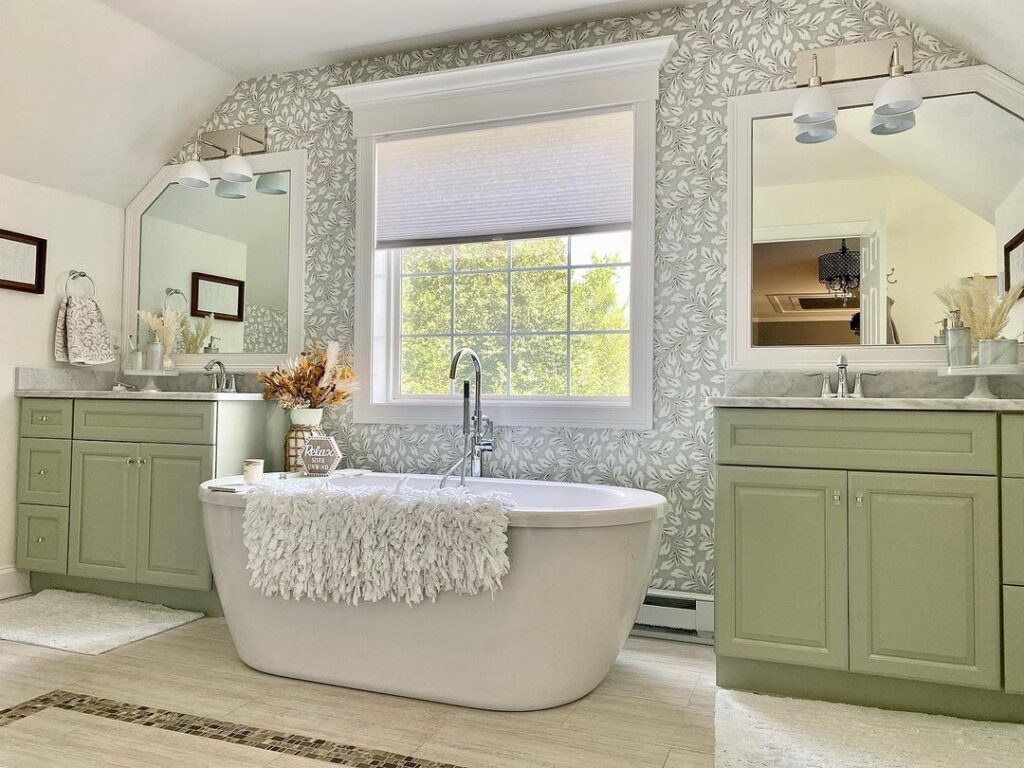This article is all about the color sage green. If you want to know more about this color, look at the articles. There’s an extensive range to pick from, so what are you waiting for? Continue reading this blog and help educate yourself about enlightening color concerns that touch your life.
Table of Contents
What is sage green?

Sage green is composed of blue and yellow in equal proportions. It is a very light green with a trace of gray, making it a perfect accent color for any area where a calming atmosphere is desired.
Sage green derives its name from the leaves of sage, which are a similar shade of green. Sage is derived from the Latin word salvia, meaning “to save.” Sage has been used for ages to cure several diseases, ranging from sore throats to fevers.
Sage has also been used as a culinary herb; it is often used in meals such as chicken soup and beef stew because it adds taste and perfume without adding calories or fat.
Benjamin Moore October Mist

October Mist by Benjamin Moore is the perfect paint color to use in a room with a great deal of natural light. It has a fresh and tidy appearance that can be used in any area, but it works particularly well in rooms with many windows or skylights. The hue is a warm gray-green that is sufficiently cold to be neutral and does not make the space seem too warm or too dark.
If you want to lighten up your environment by giving it the impression of more open space but, at the same time, make it comfortable enough for the winter, October Mist is an excellent option. In places like kitchens and bathrooms, where there isn’t a lot of natural light, it’s the ideal way to bring some coziness into the environment.
Benjamin Moore Saybrook Sage

Source: dd_design_decor Instagram
Benjamin Moore has come up with a brand new hue called Saybrook Sage, which is the ideal blend of sage green and gray. The hue is refined and classy, with a tinge of contemporaneity that sets it apart.
It has been decided that Saybrook Sage will be the color of the year. This indicates that it is one of the hues that customers all across the globe choose to purchase the most. It is also popular among interior designers, many of whom like the use of subdued tones in the work that they do.
The hue was produced by merging two distinct tones: a toned-down form of sage green and another toned-down version of sage brown. The result is a hue that is a mixture of both original colors yet with a personality of its own.
Sage green has been around for centuries, but in recent years it has become more popular than ever before, thanks to its adaptability and ability to work well with other colors such as navy blue or black. Although sage green has been around for centuries, it has become more popular than it has ever been.
Best sage green paint colors

Green may not be easy to live by, but it is simple to use in interior design, particularly when painting colors for the walls. Because green is so versatile in terms of the other colors it can be paired with, it is often used as a paint color when constructing contemporary but traditional interiors.
Sage green is the most beautiful of all the conceivable colors of green. Sage green is a paint color that is organic and earthy, which helps it to ground whatever place it is utilized in. Do you need evidence? Following are some of the interior designers’ favorite sage green paint colors that they shared with us. You won’t ever look back on these colors with regret since they are so timeless and classic.
- French Gray by Farrow & Ball
Although dusty greens are enjoying their moment in the limelight, because of their muted, earthy tone, this color is a neutral we foresee employing for many years. It has a highly calming effect and may provide peace and tranquility to any environment. It goes well with delicate white walls and lighter tones of wood, but its true strength lies in its ability to complement dark accents. It would look lovely as a stair accent with black railings.
2. Texas Sage by Benjamin Moore
Texas Sage is the name of this stunning sage green hue that Benjamin Moore created. It has the appearance of a mellow olive with warm overtones of silver. It’s so versatile that I wouldn’t be scared to put it anywhere: on the walls, the trim, the doors, or the cupboards.
3. Oil Cloth by Benjamin Moore
It is easy to use in new areas, where it will help establish a calm tone, or it may be incorporated into existing spaces, bringing a new and relaxing experience. Oil Cloth is a bit of a chameleon color—at times, looking like a fresh sage, and at other times like a muted, soft gray-green. Because it has an earthy tone, it is an excellent choice for bedrooms and offices.
4. Green Smoke by Farrow & Ball
Green Smoke is an excellent complimentary hue since it goes well with various other colors and finishes. It is a flawless sage that may function as a neutral, allowing other things in the space to take center stage. Matching is not something you need to be concerned about regarding Green Smoke. This shade may be paired with various colors, ranging from gold to black to plum to navy. In addition to this, it is adaptable to many different kinds of rooms.
5. Kennebunkport Green by Benjamin Moore
The one color that can be considered neutral is green, and it always has been. Green is one of those colors that looks well with almost every other hue. This one is calming, as most sage greens ought to be, but it has just the proper depth to set the tone for a space. Consider combining this earthy tone with various colors of white and ivory, as well as woven or crocheted items that provide a wide variety of textural details.
Does sage green go with gray?
While sage green and gray are both colors of green, they are vastly distinct. Sage green is a lighter, yellowish-green hue, while gray is a deeper, blue-green hue.
The color wheel may assist you in determining whether or not specific colors are complementary. Sage is located on the color wheel between blue and yellow. Next to red and black is gray. If you examine the color wheel, you’ll see that sage and gray are opposite or straight across from one another.
If you have a sage green item and want to match it with a gray piece, consider combining it with a yellow or similar light-colored piece. Consider utilizing white or cream as an accent color, so your ensemble doesn’t seem too dark overall!
FAQs
What is sage green used for?
The most common use for sage green is in architectural design, particularly as a wall and ceiling paint hue. In addition to that, the hue may be seen on many pieces of furniture and kitchenware. Additionally, sage green is often used in the fashion industry, particularly as an accent hue.
What is sage green?
The hue sage green may be described as having undertones of both blue and green. It is a hue that seems extraordinarily natural and has been used for a very long time in the design of interior spaces. It is a hue that is incredibly peaceful, and it can be utilized to create an environment of peace and tranquillity in whatever space you choose to use it in.
Why is it called sage green?
The “sage” plant refers to the green hue known as “sage green.” There are many different tints and tones of green than this one, but this one is a shade of green. The color sage green got its name from the fact that it looks a lot like the leaves of the sage plant.
Conclusion
The living room, dining room, and bedroom all look fantastic when decorated in a sage green color since it is a stunning and calming hue. In addition, sage green is an excellent choice for those interested in finding an alternative to, or a replacement for, the widely used shade of mint green. Sage green is a hue that can give off a relaxing and cozy vibe while also giving off a strong and bold vibe, and because of this, there are a lot of possibilities out there when it comes to creating interiors with sage green paint.

